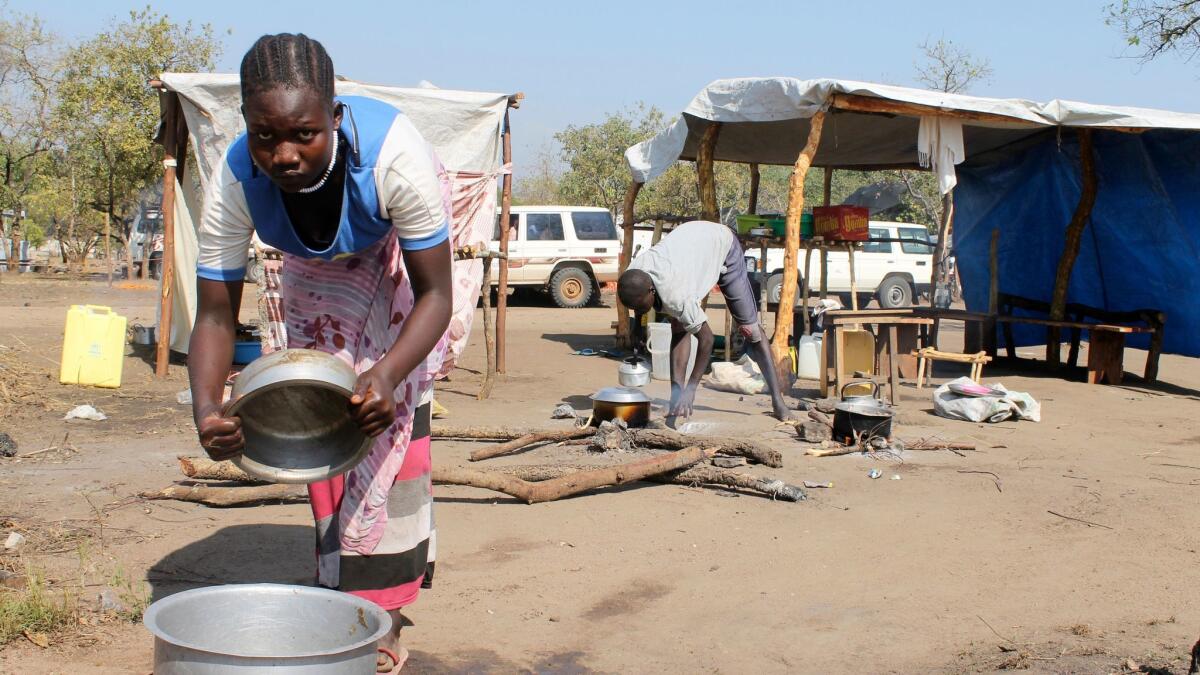South Sudan just avoided a U.N. arms embargo. But can it dodge famine and genocide?

- Share via
Reporting from Johannesburg — In a year of grim news, the spread of fighting in South Sudan has doubled the number of people facing severe hunger in the past year to 4.6 million, about a third of the population.
The risk of famine and genocide in the coming months is dire, international aid agencies have warned. The number of refugees pouring from South Sudan into Uganda peaked earlier this month at 7,000 a day.
But the United Nations Security Council on Friday failed to pass a U.S.-proposed arms embargo on South Sudan that many see as crucial to preventing escalated fighting and the threat of genocide.
South Sudan has seen growing ethnic tension since the July collapse of a peace deal that was supposed to end a civil war that began in 2013.
The latest report of the Food and Agriculture Organization predicts “an unprecedented deterioration of the food security situation across South Sudan in 2017. The risk of famine is real for thousands of people.”
As the crisis unfolds, South Sudan, a country whose spending on health and education is a fraction of what it spends on the military, has been hampering humanitarian agencies and expelling international aid workers and journalists. In recent weeks, for example, the government expelled two officials from the Norwegian Refugee Council without explanation.
The crisis has been caused by the collapse of the economy, the world’s highest inflation rate (835% per year) and the spread of fighting to central and western Equatoria, two regions in the south and southwest of the country that form the breadbasket of the nation.
South Sudan gained independence from Sudan in 2011, but civil war broke out on ethnic lines in December 2013, pitting the Dinka tribe of President Salva Kiir against the Nuer tribe of his archrival, Riek Machar. A peace deal was signed in August last year, but after repeated violations, renewed fighting gripped the capital, Juba, in July, and Machar fled the country. Three million people have been driven from their homes by fighting since 2013.
Until this year, the Equatoria region had been peaceful. But fighting and a proliferation of rival militias has seen farmers flee their land, and trade routes have often been cut. As a result, food imports from neighbors have plummeted and prices have soared.
“That has implications for the entire country,” Fred McCray, CARE’s director for South Sudan, warned in a phone interview. “Farmers have not been planting, which means that the country as a whole is less able to feed itself because some of the most productive land has gone offline. But as the conflict has spread, less [donated] food is getting in because the roads are insecure and dangerous.”
He said most food aid has had to be transported by air — a costly option — because traveling by road is unsafe. When agencies have transported food by road, they have had to negotiate with up to 17 different armed groups.
“The South Sudanese people are very strong, resilient people, but this is pushing them to the brink,” said McCray.
In two of South Sudan’s 10 regions, Unity and Northern Bahr el-Ghazal, malnutrition is at more than double the emergency threshold level. It exceeds the threshold in five other regions.
“This is cumulative. The longer the crisis goes on and the more it spreads to different areas, the more disastrous it becomes for the people of South Sudan,” said Challiss McDonough, spokeswoman for the World Food Program in Nairobi, Kenya.
One of the hardest hit regions is Bahr el-Ghazal in the northwest part of the country, where almost 1 million people, or 70% of the population needs emergency food assistance, McDonough said.
“It requires a sustained humanitarian effort to prevent a catastrophe,” she said.
South Sudan, almost totally dependent on oil, has been hit by the fall in oil prices and the loss of production in some areas due to conflict.
One of the world’s least developed countries, the country’s problems have been exacerbated by corruption and bad governance. The 2015-16 budget saw 43% of spending dedicated to the military and security forces, compared with just 9% for health and education combined. Year after year, international aid has plugged the gaps, with humanitarian agencies expected to pour in $1.4 billion in 2016-17, according to South Sudan’s Finance ministry.
“The government has consistently failed to demonstrate any willingness to alleviate what is by every empirical measure among the worst countrywide humanitarian emergencies in the world,” said a report by a panel of experts to the U.N. Security Council last month. It warned that armed groups on all sides were preparing for “an even more catastrophic escalation of violence.”
In a statement to the Security Council last month, the U.N. special advisor on the prevention of genocide, Adama Dieng, sounded an alarm on the risk in South Sudan amid escalating ethnic violence.
“I was dismayed that what I saw and heard in South Sudan confirmed my concerns that there is a strong risk of violence escalating along ethnic lines, with the potential for genocide. I do not say that lightly,” Dieng said.
Twitter: @RobynDixon_LAT
MORE WORLD NEWS
After decades of violence, can Somalia ever hold a free democratic election?
Kerry pushes back on Israeli complaints, calls for revival of peace talks with Palestinians
More to Read
Sign up for Essential California
The most important California stories and recommendations in your inbox every morning.
You may occasionally receive promotional content from the Los Angeles Times.










